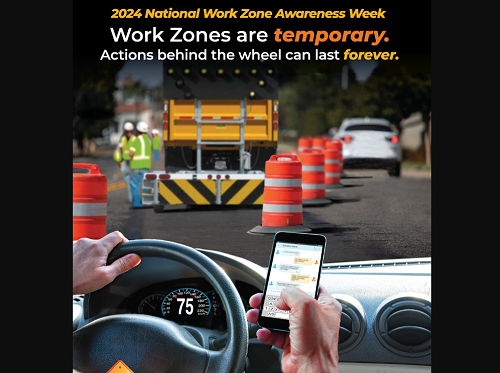Across the country, state departments of transportation are gearing up to support the 2024 National Work Zone Awareness Week or NWZAW campaign April 15-19, with the Maryland Department of Transportation paying special tribute to the six members of pothole patching crew killed during the collapse of the Francis Scott Key Bridge outside Baltimore in March as well as the six highway workers killed in an Interstate 695 work zone crash in March 2023.
[Above image via ATSSA]
“Every state DOT in the nation and the AASHTO community are doing everything in our power to make our roads safer,” noted Jim Tymon, executive director of the American Association of State Highway and Transportation Officials.

“We know that supporting the critical work of our partners – public, private, and non-profit – will advance our collective efforts to reduce work zone crashes, injuries, and fatalities, as well as fatalities and injuries more broadly on America’s roadways,” Tymon said. “We all have different capabilities, jurisdictions, and responsibilities so we need to rely on partners to work in areas where we cannot. Working together, we can comprehensively combat traffic fatalities and serious injuries on our nation’s roads.”
“Men and women shouldn’t need to fear for their lives when going to work to provide safe highways for the motoring public. Unfortunately, that is the reality,” said Stacy Tetschner, president and CEO of the American Traffic Safety Services Association or ATSSA, in a statement. “Drivers need to pay attention to signs that a work zone is ahead, realize that the work being done is to benefit them and exercise caution. One life lost is too many.”
Each day of the 2024 NWZAW campaign has a distinct focus, ATSSA noted:
- April 15 – Work Zone Safety Training Day in which companies are encouraged to pause during the workday for safety demonstrations, discussions about safety policies and other prevention steps to protect people in work zones.
- April 16 – The National Kickoff Event, hosted this year by Maryland DOT near the location of the fatal 2023 work zone crash on I-695. In addition, state DOTs and other transportation agencies will be hosting safety events in their respective locations nationwide.
- April 17 – Go Orange Day when everyone is encouraged to wear orange to show support for work zone safety and the families of victims who have lost their lives in work zones. Photos can be posted on social media with #NWZAW and #Orange4Safety.
- April 18 – A social media storm in which organizations, companies, agencies and individuals are encouraged to share messages and use hashtags #NWZAW and #WorkZoneSafety on social media posts between 9 a.m. and 4 p.m. ET.
- April 19 – A Moment of Silence during which everyone is encouraged to pause to remember the men, women, and children who have lost their lives in work zone incidents.
NWZAW was established more than two decades ago to increase attention to the need for motorists to exercise caution when approaching and passing through roadway work zones. Statistics show that the people at greatest risk from work zone crashes are drivers and their passengers.

ATSSA noted that – in 2021, the most recent year for which statistics are available – some 956 people were killed in work zones with another 42,000 injured, according to the National Work Zone Safety Information Clearinghouse.
To highlight the dangers faced by highway work crews, the Washington State Department of Transportation recently detailed in a blog post the trauma suffered by Beth Blankenship and five of her co-workers when they were hit by a speeding motorist. Though her injuries in that crash were not life threatening, Blakenship required two months of recovery before she could return to work.
WSDOT also noted in a separate blog post that the number of fatal crashes in marked work zones doubled in 2023 compared to 2022. Overall in 2023, the agency tallied 1,228 reported collisions in a work zone or in a related back-up and 28 serious injury-related collisions in work zones – with driving under the influence or DUI cited a factor in seven of its 2023 work zone crashes. Furthermore, in just the first two months of 2024, the agency has already recorded two work zone crashes involving drivers suspected of being impaired.
Distracted driving is also becoming a bigger issue where highway work zone crashes are concerned.
According to a recent survey by the Colorado Department of Transportation, over 75 percent of the motorists polled by the agency said they use their phone while driving.
The Colorado DOT added that, according to its Problem Identification Report, distracted driving was the third leading cause of traffic crashes in 2021, and from 2012 to 2022, 718 Coloradans lost their lives in a distracted driving crash.
Furthermore, national data tracked by Cambridge Mobile Telematics estimates that, nationwide, there has been a 23 percent increase in distracted driving since 2020, which has led to an additional 420,000 crashes and 1,000 fatalities.
“The consequences of distracted driving can be fatal, and we are counting on Coloradans behind the wheel to be aware of our roads at all times,” said Darrell Lingk, director of the Colorado DOT’s Office of Transportation Safety, in a statement. “Resist temptations like checking your phone or eating while driving. Whatever it is, it can wait until you have reached your destination.”



